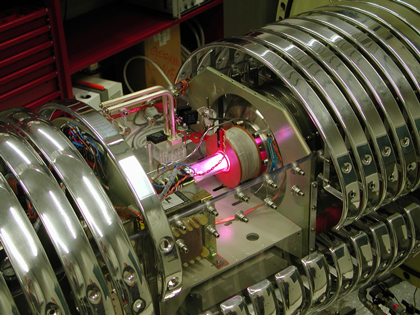PRIMORDIAL NUCLEOSYNTHESIS IN A LABORATORY: THE LITHIUM PROBLEM
The LUNA (Laboratory for Underground Nuclear Astrophysics) experiment, financed by INFN, measures directly cross sections of thermonuclear reactions of astrophysical interest. An accelerator installed in the underground Gran Sasso Laboratory is capable to produce proton or alpha beams, which then impinge onto gaseous or solid targets: the reaction products are detected by specific apparata.

The most important obtained results concern key reactions of the Hydrogen burning, fundamental for energy production, element nucleosynthesis and neutrino production. Recently, the reaction responsible for the creation of Lithium-6 during Big Bang nucleosynthesis has been measured at LUNA.
The experiment was feasible due to almost 1400 meters of rock that shield the underground Gran Sasso Laboratory from cosmic radiation impinging on Earth. The reduced cosmic background allowed the measurement of a very feeble signal, as that expected from this reaction.
The results, published in July on Physical Review Letters, confirm the existence of the so-called "lithium problem", a discrepancy between the quantity of Lithium thought to have been produced almost 14 billions of years ago and the one observed in very ancient stars. The lightest elements like Deuterium (heavy Hydrogen), Helium and Lithium formed few minutes after the Big Bang when the expanding cosmos cooled down enough to let protons and neutrons bind into atomic nuclei.
The theory that describes this primordial element production, called Big Bang Nucleosynthesis, successfully predicts the abundances of Deuterium and Helium that astronomers observe in ancient star. On the other hand, the forecast on the Lithium supply is not satisfactory at all. In particular, for Lithium-6, (3 protons and 3 neutrons), the observed quantity is higher than the prediction by a factor of 1000. To explain such a discrepancy, scientists of the LUNA collaboration decided to verify Big Bang Nucleosynthesis theory for Lithium-6 production creating in the underground Gran Sasso Laboratory the energetic conditions of few minutes after the Big Bang and measuring the cross section of the reaction responsible for Lithium-6 production.
The obtained result confirm that Lithium-6 production is in agreement with Big Bang nucleosynthesis theory prevision. Therefore, it will be necessary to find new mechanisms to explain why astronomical observations give a Lithium-6 quantity more than a factor of 1000 higher.
New physics scenarios beyond the standard models are needed! http://journals.aps.org/prl/abstract/10.1103/PhysRevLett.113.042501
Alessandra Guglielmetti for the LUNA collaboration